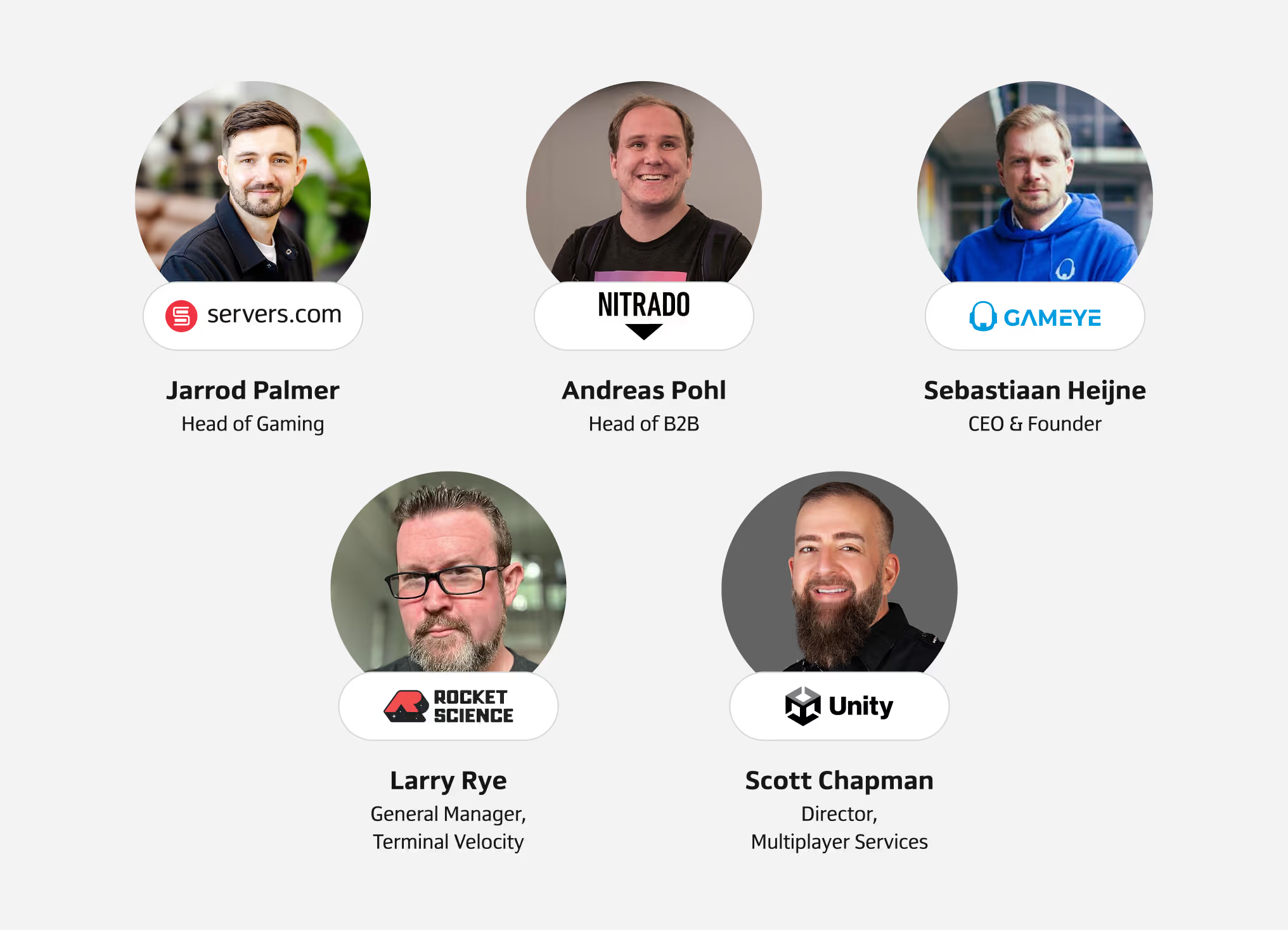

Think about the first time you drove a car and how it felt. That’s what our Head of Gaming, Jarrod Palmer invited the audience to do when introducing his panel discussion at GDC last month:
“Left alone, you don’t know what your blind spots are, you don’t know what you don’t know – it’s scary. Launching a game for the first time is just the same… you need a driving instructor with you.”
Focusing on the topic, ‘how to choose the perfect server hosting setup for your multiplayer game,’ the panel brought together four leading multiplayer gaming experts, ready to provide some much-needed expert driving instruction to new indie developers and studio founders.
In this blog we’ll recap the highlights, so whether you couldn’t make it or just need a recap, read on for the best takeaways from our experts.
Table of contents
Jarrod was joined by four leading experts from across the full ecosystem of multiplayer game server hosting, all of whom have helped launch some of the industry’s most popular games.
Andreas Pohl, Head of B2B at Nitrado: Andreas specializes in highly scalable systems and cloud computing. He’s passionate about helping game developers overcome their most pressing challenges and has already used his expertise to support over 50 indie AAA productions.
Sebastiaan Heijne, CEO and Founder at Gameye: Sebastiaan is a pioneer in high-performance, agnostic compute solutions for multiplayer gaming and has been instrumental in driving advancements that redefine online gaming experiences.
Scott Chapman, Director of Multiplayer Services at Unity: Scott specializes in scalable multiplayer gaming infrastructure, cloud gaming and real-time voice technology. He works with studios to solve complex multiplayer and cloud scaling challenges.
Larry Rye, General Manager at Terminal Velocity: Larry has played a key role in supporting the launch of titles such as Apex Legends, Call of Duty: Warzone, PUBG, Rocket League, and Among Us. He focuses on optimizing core game services, cloud infrastructure, and server orchestration.

There are a lot of potential points of failure when preparing for your game launch, especially if you’re doing it for the first time. And most mistakes happen because of blind spots. To reiterate Jarrod’s opening statement, you don’t know what you don’t know. The good news is that with some expert guidance, many of these mistakes can be avoided.
One of the most common pitfalls is a lack of preparation so testing at every stage is critical. Oftentimes when a major game launches, server issues stem from overlooking a new software that’s been running in connection to the underlying infrastructure.
And the best way to avoid this is to always overprepare. Start testing months and months in advance and anytime something new is added, test again.
“The launches that we’ve done that have been extremely successful have all been over prepared.” said Scott.
Novice developers often fail to extend their preparation to every point in their player journey or leave it until two or three weeks before launch, by which point it’s far too late. There’s a tendency to overlook important foundational stages likes building out a synthetic testing plan and considering which parts of the player journey that testing plan is going to hit.
“People leave these things generally until very late in the process or in the middle of the game development journey. But actually, if you start thinking about them very early on, about how it intrinsically links to your game design and how it can be built organically, that’s where you build success.” said Larry.
Mismanaging spend is another common mistake. The temptation can be to try and save as much cash as possible early in the game development process and then throw money at any problems that arise after launch. But most of the time that’s the wrong way round. Because by launch day, it’s already too late to make foundational improvements.
“Of course you can throw money at it,” said Andreas. “But improving it is going to be hard so it’s better to invest early in infrastructure and testing -figuring stuff out with people who actually have experience running these things.”

“The launches that we’ve done that have been extremely successful have all been over prepared.”
It’ll come as no surprise then, that the key to a successful game launch lies in being prepared. But it’s also about being able to make tough decisions when things don’t go to plan.
There was an overriding agreement amongst the panelists that, when it comes to ensuring a successful game launch, preparation is everything. The launch of battle royale hero shooter, Apex Legends, is a prime example, as Scott shared:
“It was a team effort to be overly prepared for launch and it went great. Months of effort and scale testing way beyond what it could have possibly done – it was the key to the success of the game.”
In practice, adequate preparation means defining a launch date and factoring in three (if not more) months for large scale synthetic testing of every component before that launch date. You’ll be working with multiple different partner service providers so knowing where the weak link might be is incredibly difficult. And that’s where scale testing comes in.
“Scale testing allows you to find out what’s going to happen before launch day and that’s the critical piece. When we were doing the scale testing for Apex, this was probably six months’ worth of effort, but we did it. We did three large scale tests over that time and with each one we found a problem in another provider’s system.” said Larry.
Successful developers ensure they have observability over every single component within their platform. It’s key to being able to identify where bottlenecks are occurring – whether that’s at the server, build, deployment or cluster level.
“Invest in monitoring and get the data, get the accuracy so you know where the bottlenecks are – don’t just blame the server.” said Sebastiaan.
And you don’t have to do this all alone. As Sebastiaan, goes on to advise, it’s so important to lean on your community both before and after the launch of a game.
“The most successful games that we’ve launched so far are the games that had a community around them, that grew with them, that were there to test the games together and give feedback and organically improve.”
After launching a game, there are times when you’ll have to make difficult decisions. As Andreas puts it, “you have to be willing to cut off your arm in order to save your life.”
Sometimes you’ll need to sacrifice parts of your solution that are not critical to keep that core player experience alive. Say, for instance, your entitlement service goes down. Yes, it will slightly impact player enjoyment, but it shouldn’t restrict everyone from playing the game.
It’s the principle of graceful degradation and, as Larry summarizes, “understanding which components are required to actually support the player base.”

“Scale testing allows you to find out what’s going to happen before launch day and that’s the critical piece.”
One of the biggest challenges that comes with every game launch is uncertainty. And this is especially tricky when it comes to deciding what, and how much, infrastructure to deploy.
Predicting how many players are going to turn up on launch day or even where those players will be is near impossible without a crystal ball. That said, there are steps that game studios and developers can take to mitigate these challenges.
If you’re launching a traditional box title, there are some metrics you can use but in the digital world it’s much harder. It means designing your infrastructure in a way that allows you to remain flexible is critical.
For Andreas, the key to that is hybrid infrastructure. Starting in the hyperscale cloud then planning a gradual move to dedicated game servers in a bare metal cloud solution as soon as you can pinpoint daily active user concurrency.
“At some point you will reach a situation where you’re saying, okay I’m committing to bare metal for three months, that’s really expensive and I really, really hate that [but] it will still be cheaper than running it for one day at one time.”
For Sebastiaan, that flexibility extends to the entire orchestration solution:
“Make sure you have a very flexible orchestration solution that can make moves around loss of text, can move around internet problems, move around data center problems.”
“I think it’s important that when you’re doing your capacity planning, to slightly over provision.” said Larry.
Overprovisioning your infrastructure is good practice for game launches and should form part of your capacity planning. If you’re using a hybrid orchestration system with a mix of bare metal and cloud, prepare for your launch day by firing up as many quotas as you can with your cloud provider with as much bare metal as you can afford monthly.
After a period of overprovisioning to get you through game launch, you can start to look for efficiencies like optimizing your density of servers.
“Where you were able to fit 20 players on a server at launch, you scale that down and you get more efficient on making those machines work harder for you over time. That’s really a luxury of having a game that’s been around for a while.” said Scott.

“The most successful games that we’ve launched so far are the games that had a community around them.”
Ultimately, every game is different. When it comes to first person shooters where session time is low, the impact of a temporary server downtime will be minimal. But for survival and Massively Multiplayer Online (MMO) type games, the situation is very different. These games can get incredibly data and persistence heavy, meaning that any server downtime could spell disaster.
It’s in these instances that you really want to be designing for flexibility.
“If you think about the way that MMOs are generally built out from an infrastructure perspective, it’s much more similar to an enterprise ecommerce type solution.” said Larry.
“If you think about the way that Warcraft plays, or any of these other MMOs that have instances, or different parts of your environment that you transport them to, that’s where I think we should be looking more to scalable infrastructure… you can have an instance that is available for the player or the group of players that are going to play for that particular session, and then it can go away again.”

“Invest early in infrastructure and testing -figuring stuff out with people who actually have experience running these things.”
Launching a game involves countless moving pieces. It’s not easy and there’s no failproof manual for the job. Because of this, the key to a successful launch lies in the preparation.
As all our panelists shared, it’s about affording yourself the flexibility to deal with the unknown. And that also means affording yourself flexibility at the infrastructure level.
Hybrid infrastructure has been one of the standout gaming trends in 2025 and this panel discussion highlights that it’s a strategy backed by experts.
It makes sense. Flexibility at the infrastructure level enables studios to adapt to unexpected and changing concurrent usership – and to act on Andreas’ closing piece of advice:
“Gracefully handle the unknown but be prepared for everything else that you can.”
Many thanks to Andreas, Sebastiaan, Scott and Larry for their participation and insights.
Looking for multiplayer game server hosting advice? Get in touch with our team to learn about dedicated game servers.